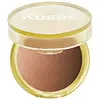Haus Labs By Lady Gaga Power Sculpt Velvet Bronzer Versus Kosas The Sun Show Glowy Warmth Baked Bronzer
What's inside
What's inside
 Key Ingredients
Key Ingredients

 Benefits
Benefits

 Concerns
Concerns

 Ingredients Side-by-side
Ingredients Side-by-side

Synthetic Fluorphlogopite
Calcium Sodium Borosilicate
Squalane
EmollientNeopentyl Glycol Dicaprylate/Dicaprate
EmollientHydrogenated Polyisobutene
EmollientMica
Cosmetic ColorantCaprylic/Capric Triglyceride
MaskingSorbitan Isostearate
EmulsifyingSodium Hyaluronate
HumectantPseudozyma Epicola/Sunflower Seed Oil Ferment Extract Filtrate
Emulsion StabilisingArnica Montana Flower Extract
MaskingTocopherol
AntioxidantAscorbyl Palmitate
AntioxidantTocopheryl Acetate
AntioxidantPersea Gratissima Oil
Skin ConditioningDimethicone
EmollientHydrogenated Rapeseed Oil
EmollientEthylhexylglycerin
Skin ConditioningEthylhexyl Palmitate
EmollientSilica
AbrasiveCaprylyl Glycol
EmollientTrihydroxystearin
Skin ConditioningPentaerythrityl Tetra-Di-T-Butyl Hydroxyhydrocinnamate
AntioxidantPolysorbate 60
EmulsifyingHydrogenated Styrene/Isoprene Copolymer
Ethylene/Propylene/Styrene Copolymer
Butylene/Ethylene/Styrene Copolymer
BHT
AntioxidantCI 77891
Cosmetic ColorantCI 77491
Cosmetic ColorantCI 77007
Cosmetic ColorantCI 19140
Cosmetic ColorantCI 15850
Cosmetic ColorantSynthetic Fluorphlogopite, Calcium Sodium Borosilicate, Squalane, Neopentyl Glycol Dicaprylate/Dicaprate, Hydrogenated Polyisobutene, Mica, Caprylic/Capric Triglyceride, Sorbitan Isostearate, Sodium Hyaluronate, Pseudozyma Epicola/Sunflower Seed Oil Ferment Extract Filtrate, Arnica Montana Flower Extract, Tocopherol, Ascorbyl Palmitate, Tocopheryl Acetate, Persea Gratissima Oil, Dimethicone, Hydrogenated Rapeseed Oil, Ethylhexylglycerin, Ethylhexyl Palmitate, Silica, Caprylyl Glycol, Trihydroxystearin, Pentaerythrityl Tetra-Di-T-Butyl Hydroxyhydrocinnamate, Polysorbate 60, Hydrogenated Styrene/Isoprene Copolymer, Ethylene/Propylene/Styrene Copolymer, Butylene/Ethylene/Styrene Copolymer, BHT, CI 77891, CI 77491, CI 77007, CI 19140, CI 15850
Mica
Cosmetic ColorantLimnanthes Alba Seed Oil
Skin ConditioningHydrogenated Vegetable Oil
EmollientCaprylic/Capric Triglyceride
MaskingSilica
AbrasiveHectorite
AbsorbentSoybean Glycerides
EmollientPhenethyl Alcohol
MaskingTocopheryl Acetate
AntioxidantCaprylyl Glycol
EmollientButyrospermum Parkii Butter Unsaponifiables
Skin ConditioningButyrospermum Parkii Butter Extract
Skin ConditioningOleic/Linoleic/Linolenic Polyglycerides
EmollientSorbitan Tristearate
EmulsifyingAscorbyl Palmitate
AntioxidantCI 77163
Cosmetic ColorantCI 77491
Cosmetic ColorantCI 77492
Cosmetic ColorantCI 77499
Cosmetic ColorantCI 77891
Cosmetic ColorantMica, Limnanthes Alba Seed Oil, Hydrogenated Vegetable Oil, Caprylic/Capric Triglyceride, Silica, Hectorite, Soybean Glycerides, Phenethyl Alcohol, Tocopheryl Acetate, Caprylyl Glycol, Butyrospermum Parkii Butter Unsaponifiables, Butyrospermum Parkii Butter Extract, Oleic/Linoleic/Linolenic Polyglycerides, Sorbitan Tristearate, Ascorbyl Palmitate, CI 77163, CI 77491, CI 77492, CI 77499, CI 77891
 Reviews
Reviews

Ingredients Explained
These ingredients are found in both products.
Ingredients higher up in an ingredient list are typically present in a larger amount.
Ascorbyl Palmitate is created by combining pure Vitamin C and palmitic acid. It is an antioxidant and helps reduce hyperpigmentation.
This ingredient is a more stable version of Vitamin C, meaning it does not disintegrate as quickly when exposed to sunlight. However, studies show it does not penetrate skin as well as pure Vitamin C.
Ascorbyl Palmitate is oil soluble.
Read more about other types of Vitamin C:
Learn more about Ascorbyl PalmitateThis ingredient is an emollient, solvent, and texture enhancer. It is considered a skin-softener by helping the skin prevent moisture loss.
It helps thicken a product's formula and makes it easier to spread by dissolving clumping compounds.
Caprylic Triglyceride is made by combining glycerin with coconut oil, forming a clear liquid.
While there is an assumption Caprylic Triglyceride can clog pores due to it being derived from coconut oil, there is no research supporting this.
Learn more about Caprylic/Capric TriglycerideCaprylyl Glycol is a humectant and emollient, meaning it attracts and preserves moisture.
It is a common ingredient in many products, especially those designed to hydrate skin. The primary benefits are retaining moisture, skin softening, and promoting a healthy skin barrier.
Though Caprylyl Glycol is an alcohol derived from fatty acids, it is not the kind that can dry out skin.
This ingredient is also used as a preservative to extend the life of products. It has slight antimicrobial properties.
Learn more about Caprylyl GlycolCi 77491 is also hydrated iron III oxide. It's sole purpose is to give a red/pink hue to products.
Iron III oxides are classified as inorganic chemicals for coloring.
Synthetically created Ci 77491 is considered safer than those naturally found. This is because the synthetically created version may contain less impurities. Iron oxides are generally non-toxic and non-allergenic.
Learn more about CI 77491Ci 77891 is a white pigment from Titanium dioxide. It is naturally found in minerals such as rutile and ilmenite.
It's main function is to add a white color to cosmetics. It can also be mixed with other colors to create different shades.
Ci 77891 is commonly found in sunscreens due to its ability to block UV rays.
Learn more about CI 77891Mica is a naturally occurring mineral used to add shimmer and color in cosmetics. It can also help improve the texture of a product or give it an opaque, white/silver color.
Serecite is the name for very fine but ragged grains of mica.
This ingredient is often coated with metal oxides like titanium dioxide. Trace amounts of heavy metals may be found in mica, but these metals are not harmful in our personal products.
Mica has been used since prehistoric times throughout the world. Ancient Egyptian, Indian, Greek, Roman, Aztec, and Chinese civilizations have used mica.
Learn more about MicaSilica, also known as silicon dioxide, is a naturally occurring mineral. It is used as a fine, spherical, and porous powder in cosmetics.
Though it has exfoliant properties, the function of silica varies depending on the product.
The unique structure of silica enhances the spreadability and adds smoothness, making it a great texture enhancer.
It is also used as an active carrier, emulsifier, and mattifier due to its ability to absorb excess oil.
In some products, tiny microneedles called spicules are made from silica or hydrolyzed sponge. When you rub them in, they lightly polish away dead skin layers and enhance the penetration of active ingredients.
Learn more about SilicaTocopheryl Acetate is AKA Vitamin E. It is an antioxidant and protects your skin from free radicals. Free radicals damage the skin by breaking down collagen.
One study found using Tocopheryl Acetate with Vitamin C decreased the number of sunburned cells.
Tocopheryl Acetate is commonly found in both skincare and dietary supplements.
Learn more about Tocopheryl Acetate